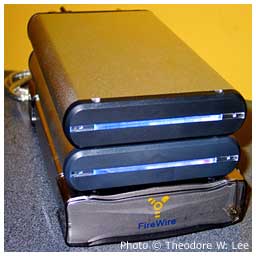Ken Sonenclar writes:
I enjoyed your 9/10/04 piece about the utility of a
slot-loading Mac for running OS X [Why the Slot Loading iMac Is a Good Choice for
OS X]. Purchasing a new eMac freed up this old buzzard (a
graphite DV
special), and I want to upgrade it along the lines you suggest: 512
MB RAM, an AirPort card, and an 80 GB hard drive.
>"One question, perhaps silly, but this will be my
first attempt at swapping memory and a drive. Though it looks easy
enough, how does one go about transferring the contents of the 13 GB
drive that I'll be removing to the new drive? Or is that not
possible?
>"And do I leave the existing 128 MB while adding
the 512 MB, or is there there only room for one or the other?"
Second question first. The iMac DV SE shipped with 128 MB of RAM.
That's a single memory module, and the slot-loading iMacs have two
memory module slots. Updrading is as easy as snapping the RAM into
place - once you have the computer open.
By adding 512 MB, you'll have 640 MB total RAM, a very nice setup
indeed.
Swapping out hard drives isn't difficult - again, once you've found
your way into the iMac's guts. Moving the data is another story, since
the iMac only has one hard drive bay.
 I'd
recommend picking up an inexpensive FireWire (or combo FireWire and USB
2.0) drive enclosure. I've used several different ones over the years,
and my current choice is the Triumph Venus 3.5" enclosure (top two
drives in photo on right), which is available in FireWire-only
and FireWire/USB
2.0 versions from the PC Micro Store. (Check with dealmac for
specials on these. I've seen them listed quite frequently, sometimes
for $30-35 including hookup cables.)
I'd
recommend picking up an inexpensive FireWire (or combo FireWire and USB
2.0) drive enclosure. I've used several different ones over the years,
and my current choice is the Triumph Venus 3.5" enclosure (top two
drives in photo on right), which is available in FireWire-only
and FireWire/USB
2.0 versions from the PC Micro Store. (Check with dealmac for
specials on these. I've seen them listed quite frequently, sometimes
for $30-35 including hookup cables.)
I'm sure there are lots of other good enclosures out there, but
these are compact, quiet, and solid. There's no cooling fan, and the
aluminum enclosure is just big enough to hold a 3.5" IDE drive and the
bridge electronics that let it work with USB and/or FireWire. Theodore
W. Lee of OS X Factor also gives this enclosure
raves.
Regardless of which enclosure you buy, it's usually a pretty easy
process to drop in your old drive, close things up, wire it up, turn it
on, and have your Mac see it. You might not even need to change any
jumpers - or you might. Check the documentation that comes with the
enclosure and the jumper settings on your drive before you put it
inside the new case.
Once it's connected, I suggest you boot from the external drive and
download Carbon Copy
Cloner (donationware, see our
review) or SuperDuper
(shareware, see our review).
Either program can duplicate the complete file structure from your old
drive to your new one, making whatever changes are necessary so the new
drive will be bootable.
I used to use CCC for duplicating hard drives, but I've found
SuperDuper does a whole lot more than clone one drive to another, so
I've paid my shareware fee and now use it as my backup software.
Once you're finished duping your drive, set your new drive as your
startup disk, restart, and enjoy the additional speed and storage space
on the new drive.
As for the old drive, you might want to turn it into an emergency
drive by leaving all the System files and utility programs on it. In
the unlikely event your iMac or eMac should have a hard drive problem,
you could boot from the external drive - a lot faster than CD-ROM - to
run diagnostics and attempt repairs.
With SuperDuper, my external drives are bootable mirrors of the
drives in my two eMacs and my PowerBook G4, which gives me
both an emergency disk and a full backup in a rugged, compact package.


 I'd
recommend picking up an inexpensive FireWire (or combo FireWire and USB
2.0) drive enclosure. I've used several different ones over the years,
and my current choice is the Triumph Venus 3.5" enclosure (top two
drives in photo on right), which is available in
I'd
recommend picking up an inexpensive FireWire (or combo FireWire and USB
2.0) drive enclosure. I've used several different ones over the years,
and my current choice is the Triumph Venus 3.5" enclosure (top two
drives in photo on right), which is available in 
